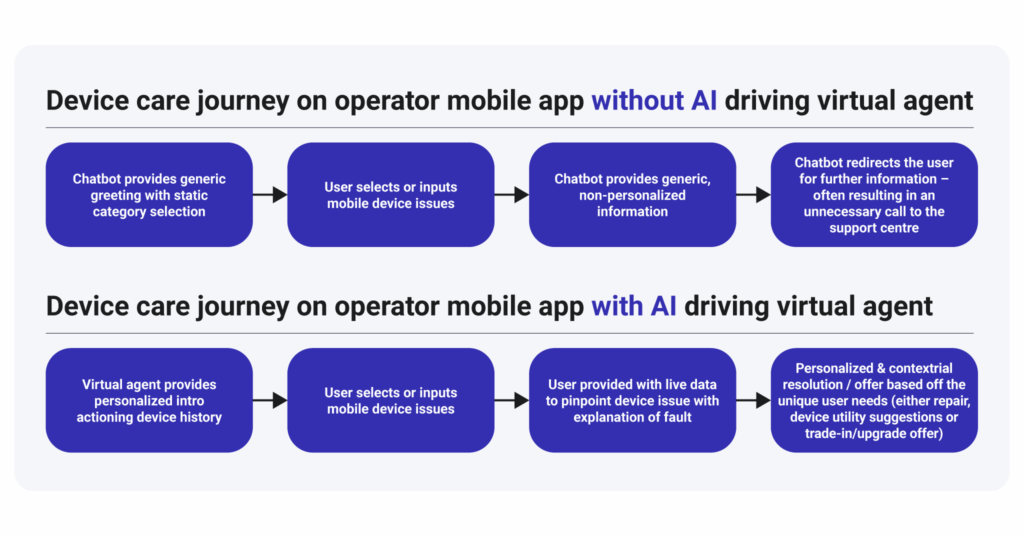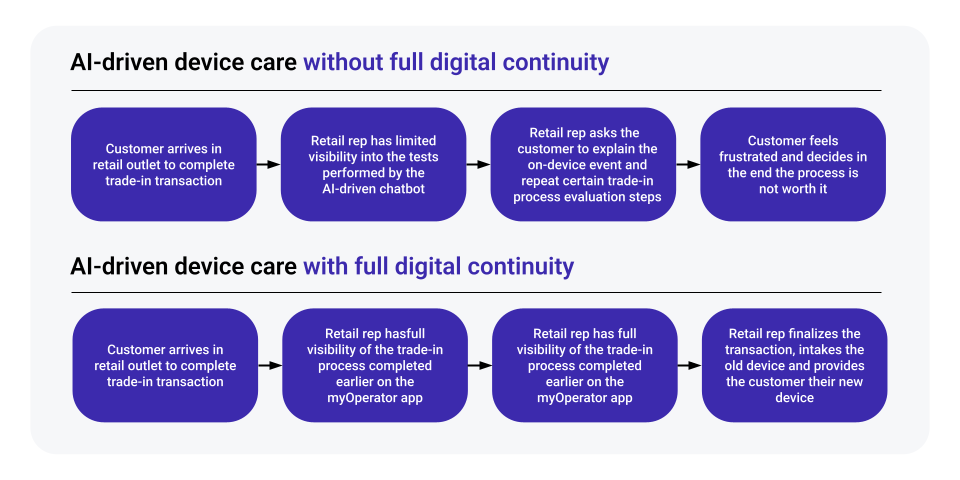Most customers prefer omnichannel engagement with their mobile operator, with 59 percent opting for a digital-first approach – defined as the ability to engage a mobile operator or solve a device-related issue remotely via a mobile app or web browser.
Mobile operators are evaluating AI technologies, like GenAI, to determine whether they can improve the customer experience, with nearly half of mobile operators prioritizing this as their main objective. Fifty-four percent of operators are investing in GenAI specifically to support this goal, adopting tools like chatbots, virtual assistants and in-store kiosks that help customers resolve issues quickly and reduce reliance on live support. AI, however, will not deliver the desired ROI if the customer journeys it’s designed to optimize are not cohesive and seamless.
In today’s landscape, customers experience what we might call fragmentation and friction, whereby experiences between channels are disconnected and frustrating. Customer mobile device care scenarios are the primary examples, where NPS drops by 19 points as soon as an incident occurs. AI can be a powerful tool in device care situations to help steer customers toward positive experiences and optimal resolutions, such as offering trade-in or upgrade alternatives to repair. But fragmented journeys completely inhibit this.
For example, a customer can start a device care journey on one channel, such as the myOperator mobile app, and subsequently visit a retail store or call the support center, and have to restart the process all over again. This phenomenon occurs in more than 60 percent of customers and leads to a nine-point NPS drop. It is a dangerous point for risk of churn.
These kinds of negative experiences typically happen due to a lack of digitization, which in turn yields the following limitations:
- Mobile operators lack remote intelligence for customers to self-troubleshoot the problem, rendering them frustrated and needing to visit retail unnecessarily
- A disconnected experience between channels, with device care services varying between channels
- Limited data on device history, inhibiting the retail or call center rep from picking up where a customer left off with device troubleshooting
Let’s imagine how this plays out when a mobile operator adds AI into a device care flow, but the journey is not digitized and thus not seamless. A customer accesses their myOperator app looking to troubleshoot their device-related issue. AI built into the app analyzes the customer’s CRM data while also identifying a device health issue, opting to offer the customer a trade-in rather than a repair.

The customer accepts the offer and goes to retail in order to complete the transaction. Now let’s see what happens when manual processes pickup in retail where the customer left off on the myOperator app and the digital continuity of the journey is missing.

As we can see, AI’s positive customer experience gains can be negated by the disconnectivity of customer event data between channels. Fragmentations like this of data and channels limit the high potential of AI in customer-facing applications.
To unlock AI’s full potential, mobile operators need a digital infrastructure that enables every interaction – no matter where it begins– to continue seamlessly across all channels. In the previous example, the AI-powered trade-in recommendation only works if the retail system has access to the same device diagnostics and CRM data as the mobile app. This is what digital seamlessness looks like: a unified experience where data flows in real-time between systems, enabling AI to deliver consistent, context-aware recommendations.
Digital Device Lifecycle Management (dDLM) provides this foundation. By connecting contextual awareness, omnichannel consistency and real-time device intelligence, dDLM enables AI to function effectively across all touchpoints. The impact is tangible: NPS increases by 17 points with seamless, digital-first trade-in experiences, and 76 percent of customers say they would stay loyal to an operator applying dDLM principles. Operationally, dDLM allows frontline teams to focus less on troubleshooting and more on value – reducing in-store trade-in processing times by 78 percent, according to MCE data.
By connecting device intelligence, customer data and service channels, MCE’s dDLM platform ensures AI has the context it needs to deliver smarter, more seamless experiences – maximizing both customer satisfaction and business results.




